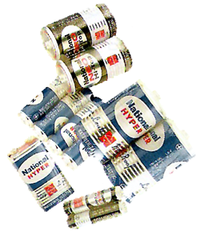
Photo from wikipedia
Abstract Battery-like materials have recently been proposed as relevant bridge materials between pseudo-capacitance and battery materials. These composites have widely been used as electrodes in hybrid supercapacitors. In this account,… Click to show full abstract
Abstract Battery-like materials have recently been proposed as relevant bridge materials between pseudo-capacitance and battery materials. These composites have widely been used as electrodes in hybrid supercapacitors. In this account, MnCo2O4 (MCO), active carbon (AC) and a series of MnCo2O4@active carbon (MCO@AC) composites were investigated as electrodes of hybrid supercapacitors in aqueous alkaline electrolytes. MCO@AC200 achieved the highest specific capacity of 443.5 C g−1 at current density of 0.5 A g−1. This composite also overcame the low utilization of active material and difficult electron transport caused by thickness of high mass-loading conditions, yielding elevated volumetric capacity of 527.13 C cm−3 at 0.5 A g−1. However, MCO@AC200 was found to suffer from poor cycle stability. To clarify the electrochemical behaviors of all hybrid electrode materials and figure out the reasons behind the short-coming, the electrochemical kinetics were analyzed by means of cyclic voltammetry, galvanostatic charge-discharge, and valence states of elements. The charge storage behaviors of MCO and AC in MCO@AC composites were found to be mutually independent. MCO as battery-like material showed irreversible phase transition, leading to deteriorated cycle stability. Overall, both electrode structure design and irreversible phase transition should be considered when developing hybrid supercapacitors with high volumetric capacity.
Journal Title: Electrochimica Acta
Year Published: 2019
Link to full text (if available)
Share on Social Media: Sign Up to like & get
recommendations!